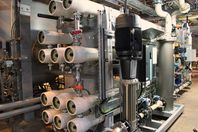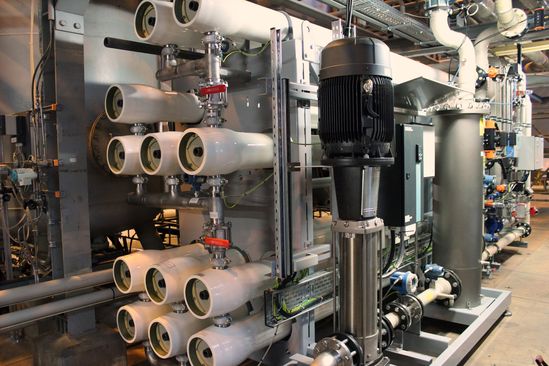Asia
EMEA

LANXESS Canada Contacts
Contact our Sites in Canada
Media Inquiries
General Inquiries
Please click here to e-mail LANXESS Canada with product inquiries and general requests.
Global Press Releases
2014-01-08
Lewabrane elements for water treatment at power plant in Chemnitz
First large-scale use of LANXESS’ membrane technology in Europe
For the first time in Europe, LANXESS’ fouling-resistant membrane technology is being used on a large scale at the Dammweg thermal power station in Chemnitz, Germany. A set of 60 Lewabrane RO B400 FR filter elements apply a reverse osmosis process to cleanse 50 to 60 cubic meters of pre-treated river water per hour for steam generation purposes. Dr. Jens Lipnizki, head of Technical Marketing Membranes in the Liquid Purification Technologies business unit at LANXESS, explains that “the 90 percent reduction in the organic contamination of river water demanded by the operator of the power plant can be easily achieved using our membrane technology.”
The reverse osmosis facility in the Chemnitz power plant was developed and designed by the Celle-based water technology company Berkefeld, a subsidiary of the global group Veolia Water Solutions & Technologies. Veolia's water technology division is one of the world's leading providers of water treatment solutions. Its core competencies lie in the planning and realization of facilities for drinking and process water treatment and the purification and recycling of wastewater.
Chemnitz powerhouse
The “powerhouse” operator is eins energie in sachsen GmbH & Co. KG. Southern Saxony’s leading municipal energy service provider has around 400,000 private and business customers, including more than 1,000 industrial clients.
The Chemnitz thermal power plant, Saxony’s highest structure with its 302-meter-high chimney, uses cogeneration to generate power and district heating. Two of the three blocks at the power plant are powered by native raw lignite using a low-emission incineration process with state-of-the-art dust removal and desulfurizing of the flue gas. The other is powered with natural gas or, alternatively, heating oil. Cogeneration technology is an optimized solution for utilizing fuels by simultaneously generating heat and electricity.
The power plant draws water for the cooling processes and steam production from the rivers Chemnitz and Zschopau. The water’s intended use – as cooling water, process water or almost pure, completely desalinated water (demineralized water) for steam generation – determines the need for any complex mechanical and chemical treatment procedures. Even after it has been softened and desalinated using ion exchange resins, the water still contains a considerable amount of organic substances that cause excessive conductivity in the water-steam cycle that is harmful to the turbine and other components. The membrane filter elements from LANXESS lower the degree of fluctuation in water quality and in particular filter out organic substances. Some 90 percent of the feed water, the permeate, is used for the ensuing processes. The remaining approx. 10 percent, the concentrate, is also put to further use by adding it to the process water.
Membrane technology for water with fouling potential
The membrane filter elements from the Lewabrane FR series that are used in the Chemnitz powerhouse are particularly suitable for water that has a high fouling potential. Each of the Lewabrane RO B400 FR elements has a membrane surface area of 37.2 square meters (400 square feet) and diameter of 201 millimeters (eight inches).
The products comprise a polyamide composite membrane that is wound in several layers to form a spiral-shaped element. “Our separation elements are characterized by a high degree of polymerization and a low surface charge, which in itself reduces the formation of particle deposits,” says Lipnizki. Furthermore, a special feed spacer has been incorporated in the newly developed FR types. “The membrane elements were designed to generate greater turbulence on the inflow side, meaning that fewer particles can accumulate on the surface,” explains the LANXESS membrane expert.
In filtration, fouling describes the process by which particles, referred to as colloids, form deposits on the membrane surface, leading to a reduction in filter capacity. The new FR elements from LANXESS reduce this kind of fouling, thereby extending maintenance intervals and increasing output capacity.
The separation elements, manufactured at LANXESS' Bitterfeld site in Germany, were engineered specifically for industrial water treatment. Fields of application include the treatment of low-salinity, brackish and wastewater with a high potential for organic or biological fouling.
More information on LANXESS membrane elements can be found at www.lewabrane.com.
LANXESS is a leading specialty chemicals company with sales of EUR 9.1 billion in 2012 and roughly 17,500 employees in 31 countries. The company is currently represented at 52 production sites worldwide. The core business of LANXESS is the development, manufacturing and marketing of plastics, rubber, intermediates and specialty chemicals. LANXESS is a member of the leading sustainability indices Dow Jones Sustainability Index (DJSI) World and FTSE4Good as well as the Carbon Disclosure Leadership Index (CDLI).
- Gallery




